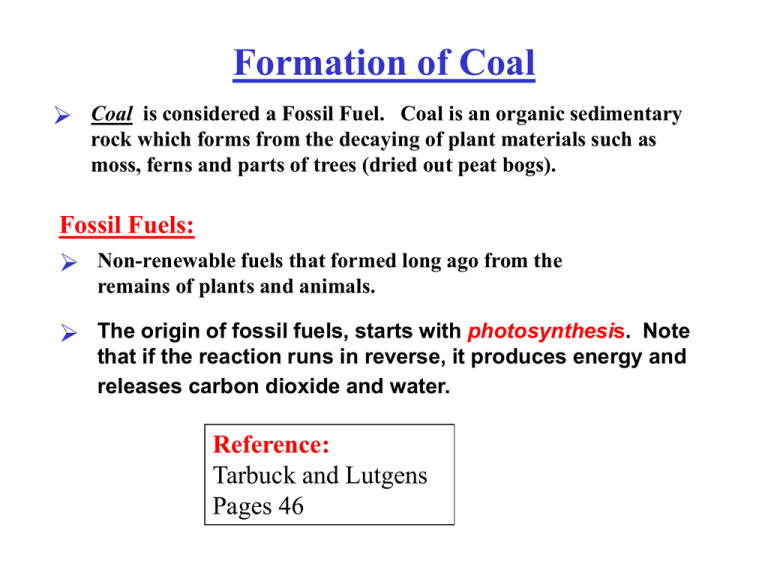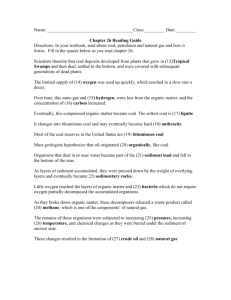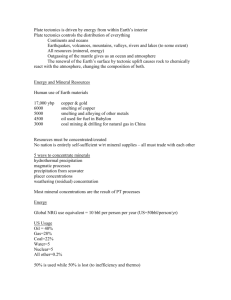Formation of Coal
advertisement

Formation of Coal Coal is considered a Fossil Fuel. Coal is an organic sedimentary rock which forms from the decaying of plant materials such as moss, ferns and parts of trees (dried out peat bogs). Fossil Fuels: Non-renewable fuels that formed long ago from the remains of plants and animals. The origin of fossil fuels, starts with photosynthesis. Note that if the reaction runs in reverse, it produces energy and releases carbon dioxide and water. Reference: Tarbuck and Lutgens Pages 46 Formation of Coal Coal is a sedimentary/metamorphic rock produced in swamps where there is a large-scale accumulation of organic matter from plants. Organic materials consist of carbon, oxygen, and hydrogen. When plant material is buried, the hydrogen and oxygen (H2O) is released leaving carbon. Coal is found in beds called seams, usually ranging in thickness from 0.5 to 3m, although some seams reach 30 m. Two major coal producing periods are known in geologic history. During the Carboniferous and Permian Periods, the continents were apparently located near the equator and covered by shallow seas. This type of environment favoured the growth of vegetation and rapid burial to produce coal. Formation of Coal The Formation of Coal Involves Several Steps: 1) Formation of Peat. Swamps are areas where organic matter from plants accumulate. As the plants die and get buried they compact to become peat. With time and more compaction, almost all of the water is lost and three different grades of coal result. 2) Formation of Lignite Coal. Compaction of the peat due to burial drives off volatile components like water and methane, eventually producing a black-colored, organicrich coal called lignite . Soft brown coal which consist of about 40% carbon and do not burn efficiently. Peat Burial Compaction Lignite Coal Seam Burial Formation of Coal The Formation of Coal Involves Several Steps: 3) Formation of Bituminous Coal. Burial Further compaction and heating results in a more carbon- rich coal called bituminous coal. Soft coal which consist of about 85% carbon and burns readily but produces a lot of smoke. 4) Formation of Anthracite Coal. If the rock becomes metamorphosed, a high grade Compaction Bituminous Metamorphism Burial coal called anthracite is produced. Hard dark coal which consist of 90% to 95% carbon and burns very hot and clean. Forms as a result of metamorphic conditions. Anthracite coal produces the most energy when burned. Anthracite Coal Seam Sample Problem Use a diagram to explain the four stages involved in the formation of anthracite coal. Answer: From peat to lignite there is burial and compaction. From lignite to bituminous there is greater burial. From bituminous to anthracite there is metamorphism. Water and gases are released during all stages.






